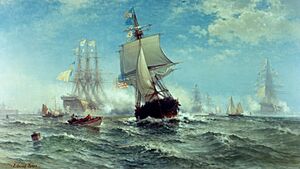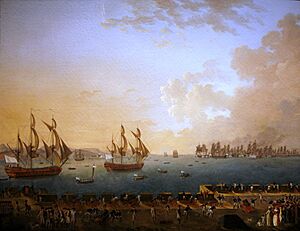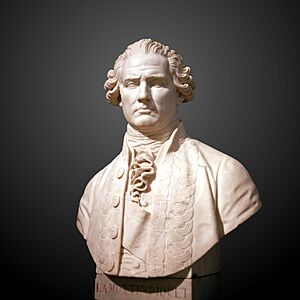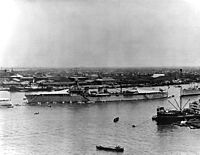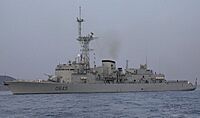Toussaint-Guillaume Picquet de la Motte facts for kids
Quick facts for kids
Toussaint-Guillaume Picquet de la Motte
|
|
|---|---|
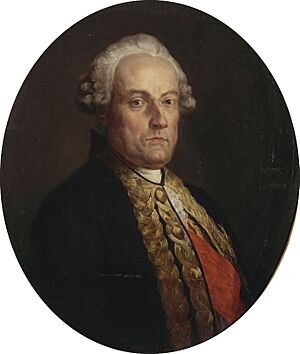
Portrait of La Motte-Piquet by Jean-Pierre Franque
|
|
| Born | 1 July 1720 Rennes, France |
| Died | 10 June 1791 (aged 70) Brest, France |
| Allegiance | |
| Service/ |
|
| Years of service | 1735-1787 |
| Rank | Lieutenant général des armées navales |
| Commands held |
|
| Battles/wars | |
| Awards | Grand Cross of the Order of Saint Louis |
Toussaint-Guillaume Picquet de la Motte, also known as La Motte-Picquet, was a brave French Navy officer and admiral. He was born on July 1, 1720, in Rennes, France, and passed away on June 10, 1791, in Brest.
La Motte-Picquet served in the French Navy for over 50 years. He fought in many important wars, including the Seven Years' War and the Naval battles of the American Revolutionary War. He was known for his skill and courage. By the end of his career, he had earned high honors, like the Grand Cross of the Order of Saint Louis.
Contents
A Young Sailor's Start
La Motte-Picquet began his naval career very young. He joined the Gardes de la Marine in Brest on July 11, 1735, when he was just 15 years old.
Two years later, he sailed on the frigate Vénus. They went on a mission to fight against the Barbary pirates near Salé. These pirates were a big problem for ships at the time.
In 1745, during the War of the Austrian Succession, he joined the frigate Renommée. This ship had an important job: to deliver messages to Louisbourg, which was being blocked by British ships. The Renommée used fog and ice to sneak past the British.
During one trip, the Renommée met a British squadron. In the fight, La Motte-Picquet's captain was badly hurt. La Motte-Picquet bravely took command and managed to escape. He was also injured, with a cannonball cutting his cheek.
After many voyages across the Atlantic and Indian Oceans, he became a Lieutenant de Vaisseau in 1754. This was a big step up in his career.
Fighting in the Seven Years' War
In 1755, La Motte-Picquet got his first chance to command his own ship. This was a great honor for him.
A year later, he was made a Knight in the Order of Saint Louis. This award recognized his bravery and service.
In 1757, he served on the ship Diadème as part of a squadron. Their mission was to challenge the British Navy near Québec. He continued to serve with distinction throughout the war.
By 1762, he was promoted to captain. He was given command of the ship Diadème. After the war ended in 1763, he continued to serve in various squadrons. He even commanded the frigate Malicieuse for a six-month trip near Canada.
He also led several missions against the Barbary corsairs. In 1776, he took command of the ship Solitaire.
Hero of the American Revolutionary War
La Motte-Picquet played a very important role in the American Revolutionary War. In 1777, he commanded the ship Robuste. On February 14, 1778, his ship fired a special nine-gun salute for the American ship USS Ranger. This was a historic moment! It was the first time a foreign warship officially recognized the United States flag.
In 1778, he became a Squadron Commander. He fought in the Battle of Ouessant. After that, he sailed in English waters and captured thirteen enemy ships in just one month.
He also joined Admiral d'Estaing's squadron in the Caribbean. He fought bravely in important battles like the Battle of Grenada and the Siege of Savannah.
One of his most famous moments was the Battle of Martinique in 1779. He attacked a British squadron that was trying to block French ships. His actions were so impressive that the British admiral, Hyde Parker, sent him a letter. In the letter, Parker praised La Motte-Picquet's skill and courage, saying he admired him greatly.
In 1781, La Motte-Picquet led a squadron of nine ships. He managed to stop a British fleet led by Admiral Rodney. The British had just captured a lot of treasure from St. Eustatius. La Motte-Picquet captured 26 British ships and recovered a huge amount of money, about 5 million pounds! Soon after this amazing victory, he was promoted to Lieutenant General of the Naval Armies.
Later Life and Legacy
After serving for 52 years, La Motte-Picquet's health declined. He suffered from severe attacks of gout. He passed away on June 11, 1791, in Brest, at the age of 70. He was buried in the local graveyard.
La Motte-Picquet is remembered as a great naval hero. To honor him, five ships of the French Navy have been named La Motte-Picquet. The most recent one is a frigate called Lamotte-Picquet, which is still in service today.
In Paris, a street in the 7th area is named after him: l'Avenue de la Motte-Picquet. There is also a Paris metro station called La Motte-Picquet – Grenelle, located on that avenue.
- Ships of the French Navy named La Motte-Picquet
See also
- French ship La Motte-Picquet
- Franco-American alliance


